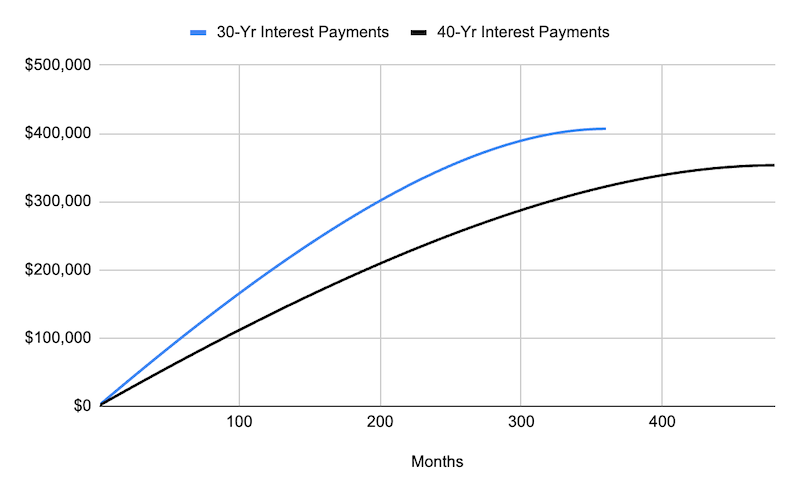It’s no secret that there’s an affordable housing crisis for many Americans. This statement is not to point fingers or assign blame (I have strong opinions about this, but I’ll save them for another day).
Election season is in full swing, and the economy, inflation, and affordable housing are major talking points for both parties. I’m not trying to turn this into a political discussion, so I’ll avoid diving into the proposed policies and my opinions of both candidates, but you can read more about them here.
However, I will discuss one of the more unique ideas I’ve read recently. In an op-ed published last month in CNBC, the CEO of Operation Hope and a former advisor to Barack Obama, John Hope Bryant, argued a 40-year mortgage is a short-term solution to housing affordability issues in America.
When I first read this proposal, I disagreed with it. In fact, the original title of this article was “A 40-Year Mortgage Would Be Terrible for Homebuyers.” But when I dove into the data and played around with an amortization schedule, I realized there are actually some financial benefits here that might be worth exploring.
John Hope Bryant’s Case for a 40-Year Mortgage
In a nutshell, Bryant’s proposal centers around the following tenets:
- Subsidizing the rate between 3.5% and 4.5% for first-time homebuyers after they complete financial literacy training.
- Subsidies would be capped at $350,000 for rural areas and $1 million for urban.
- There would be no cap on age.
A longer mortgage solution isn’t a new concept. In fact, earlier this year, Grant Cardone predicted that we may see 50- or even 100-year mortgages in our lifetime.
Spreading out payments over time means a lower monthly payment for homebuyers, which, in theory, will allow them to afford a property that would otherwise be out of reach.
Let’s Do the Math
On the surface, the numbers seem great. It would allow these buyers a more realistic entry point to homeownership and allow them to build equity over time.
I want to call out this quote from Bryant’s proposal in the CNBC article:
“Critics may argue that a longer mortgage term increases the total interest paid, but the benefits of affordability and access outweigh this drawback. For many, the alternative is indefinite renting, which builds no equity and leaves families vulnerable to rising rents and economic displacement. A 40-year mortgage allows more people to begin building equity sooner, offering a pathway to long-term financial stability and sustained human dignity.”
Here’s where I was going to make my argument that the numbers don’t support the theory. But after spending an afternoon in Excel, I discovered three reasons why this plan has merit.
1. Lower monthly payments
Bryant’s main argument was that this proposal would lower the monthly payment for properties by offering a lower interest rate longer term.
I checked that statement using the BiggerPockets mortgage calculator to come up with a monthly principal, interest, taxes, and insurance (PITI) payment. For simplicity’s sake, we’re going to use the national median home price from Redfin, property taxes from TaxFoundation.org, and insurance costs from Insurance.com. I’m including tax and insurance here to try to paint a picture of the full monthly cost for which these homeowners would be responsible.
We could make the argument that some of these homebuyers would look to put down less upfront or receive down payment assistance from the various programs out there. However, to keep these comparisons as apples-to-apples as possible, I’m sticking with 20% down to start with the same loan amount and avoid PMI—the numbers here would obviously look very different with a smaller down payment and mortgage insurance.
| Example A | Example B | |
| Loan Term | 360 months | 480 months |
| Interest Rate | 6% | 4% (split between 3.5% and 4.5%) |
| Purchase Price | $439,000 | $439,000 |
| Down Payment | 20% | 20% |
| Annual Property Taxes | 0.91% | 0.91% |
| Annual Insurance | $2,881 | $2,881 |
| Monthly PITI Payment | $2,329.00 | $1,743.66 |
This one is fairly simple and shouldn’t come as a surprise—a longer loan term with lower rates will mean lower monthly payments. In these two scenarios, the difference is about $585.
Over the course of the year, that’s more than $7,000 saved in monthly payments with a 40-year mortgage. Not too shabby.
2. Lower overall payments
My assumption was going to be that even with a lower rate, the overall interest payments would be higher with a 40-year mortgage. Bryant even made mention of that in his proposal.
However, we’re both incorrect. When looking at the lifetime of each loan in my scenario, the total interest payments stack up like this:
- 30-year mortgage: $406,823.67
- 40-year mortgage: $353,343.76
The principal remains the same at $351,200, but the 40-year mortgage homebuyer actually pays $53,479.91 less in interest payments when all is said and done.

This comparison shows that, contrary to my initial assumptions, the 40-year mortgage actually results in lower overall interest payments despite the extended loan term. Again, this calculation will change based on different down payment amounts (e.g., only putting 5% down means $419,595.95 in interest for the 40-year loan), but there are situations where a longer mortgage means the home comes at a cheaper cost.
3. Equity is a mixed bag
Bryant’s other main argument centered around equity growth for a 40-year mortgage. This is where he’s right and wrong, depending on how you analyze the numbers. It’s kind of a gray area.
How many first-time buyers find their “forever home” with their first purchase? According to GOBankingRates, the average American will move more than 11 times in their life. I may be a rare case due to an early career that forced me to relocate about every 18 months, a divorce, and a remarriage, but I’ve moved about 10 times already, and I’m 41 years old.
For the sake of argument, let’s be conservative and assume a homebuyer stays in their house for 10 years before deciding it’s time to move. I’m going to use the same national median home price and 20% down payment, but I’m not going to consider property taxes and insurance in this calculation.
Our BiggerPockets data analyst Austin Wolff manually derived one-year appreciation from Zillow MSA price data, but at 4.28%, I found it to be unrealistic over the long term. The housing market is a little unique right now. Therefore, I am going to assume appreciation at 2% annually, which I believe will be more accurate over the long term.
When you look at the 120-month mark, a 30-year mortgage has $13,543 more equity when considering home value with 2% annual appreciation and remaining mortgage balance. That gap continues to widen over time until the 40-year mortgage finally catches up at the end of its term.

Now, let’s look at this as a buy-and-hold investment. Unless this homeowner is house hacking and living for free, the down payment and monthly mortgage payments over time will take a major dent out of that equity. In fact, at 120 months, a 30-year mortgage homeowner has spent nearly $100,000 more in down payment and monthly mortgage payments compared to the equity gained through appreciation and amortization. The 40-year mortgage homeowner is only underwater by $36,000.
The 40-year mortgage owner has positive ROI starting at month 308, while it takes an extra seven years for the 30-year mortgage owner to reach the same point—well after their loan payments end.

According to my calculations, a 40-year mortgage would be advantageous to homeowners, especially those who plan on staying in the property long term or house hacking to start. Rental property investors may find some merits of the longer term, as it could generate additional monthly cash flow by lowering the mortgage obligation, but it reduces the overall equity potential when it comes time to exit the property.
The Supply-and-Demand Counterargument
There are two constant, undefeated things in this world:
- The 1959 Syracuse Orangemen (the only undefeated team worth mentioning)
- The principle of supply and demand
Despite the financial numbers looking favorable for a 40-year mortgage, I do believe this proposal could create an unfavorable shift to supply and demand. Adding more potential homebuyers to a market with limited supply will create more competition for that supply, and that will cause prices to increase.
Remember back in 2020 and 2021, when properties received dozens of offers, and buyers were waiving contingencies and due diligence? While we may not reach that level of crazy in the market, increased competition will force some homebuyers to spend more than they want to for their properties and/or skip inspections. As investors, it’s easy to walk away from a deal that doesn’t make sense, but when dealing with first-time homebuyers who are emotionally attached to a property, that FOMO is hard to resist.
We also need to consider how lenders might react to this proposal. If they are collecting less interest, would they actually try to cap the down payment to 5% or 10%? Doing that will slightly negate the cheaper monthly payment by adding PMI and cause more interest payments over time.
Therefore, I do worry this proposal to help homebuyers may have the unintended consequence of harming some of them.
Final Thoughts
I must be transparent and admit my arguments are largely based on assumptions and very basic math. All deals will look different, and depending on the buyers, this type of mortgage will or won’t work.
As I mentioned, there is an affordable housing problem in this country, and I think something needs to be done to give first-time buyers an opportunity to purchase a home.
While a 40-year mortgage may initially seem counterintuitive, it could provide significant financial advantages for some homebuyers, especially those seeking lower monthly payments and long-term affordability. However, it’s important to remain mindful of potential market impacts, such as increased demand and competition, which could inadvertently drive up home prices and create new challenges.
Ultimately, the 40-year mortgage is a tool that could benefit specific buyers, but it all comes down to strategies and goals for owners and investors.
Ready to succeed in real estate investing? Create a free BiggerPockets account to learn about investment strategies; ask questions and get answers from our community of +2 million members; connect with investor-friendly agents; and so much more.
Note By BiggerPockets: These are opinions written by the author and do not necessarily represent the opinions of BiggerPockets.
from Investment – My Blog https://ift.tt/zb5aFuC
via IFTTT






0 Comments